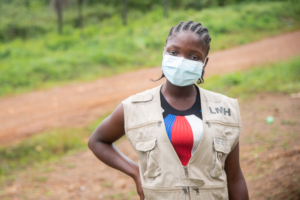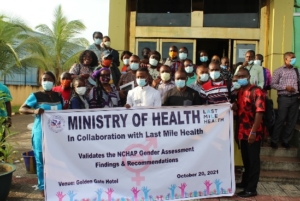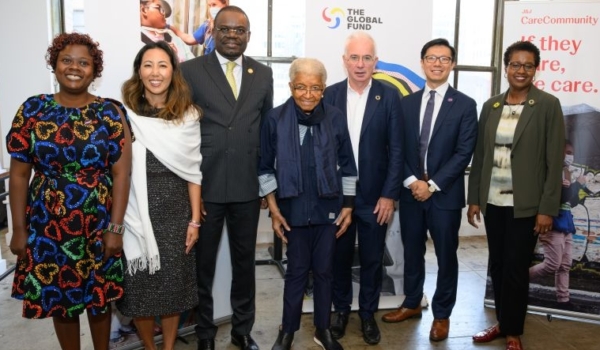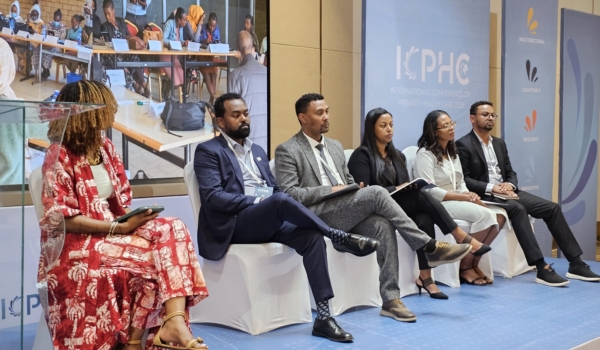This International Women’s Day, we are working to #BreakTheBias that holds us back from a gender-equal world. At Last Mile Health, this starts with understanding what barriers women face to becoming professionalized community health workers and identifying opportunities to build more gender-transformative programming.

Community health worker Naomi Davies in Grand Bassa County, Liberia
As a paid, professionalized community health worker, Naomi Davies provides essential care to more than 200 of her neighbors in Grand Bassa County, Liberia. Improving pregnancy-related health outcomes for mothers and babies is an essential part of her responsibilities and data shows that female patients prefer female providers like Naomi when receiving maternal and reproductive health services. Despite benefits like these, less than 20% of Liberia’s community health workers are women.
Launched in 2016 following the Ebola epidemic, the Government of Liberia’s National Community Health Assistant Program deploys a paid, professionalized community health worker to provide primary health services in every remote community across the country. The national program aims to give preference to women to become community health workers to harness gender-focused benefits such as improving female literacy, the social status of women, and economic empowerment. However, after five years of implementing the program, only 17% of the community health workers employed by the national program are female – despite accounting for 70% of the health and social care workforce globally.

Last Mile Health staff celebrate the validation of the gender assessment with the Liberia Ministry of Health in 2021.
In 2021, Last Mile Health joined the Liberia Ministry of Health in a commitment to increase the number of female community health workers employed in Liberia’s National Community Health Assistant Program to increase gender parity and the availability of high-quality health services for women. The commitment was made as part of the Gender Equal Healthcare Workforce Initiative, launched by Women in Global Health, the Government of France, and the World Health Organization, to address gender inequities in the health and care workforce.
The Government of Liberia, in partnership with Last Mile Health and other partners, is now revising the policy that guides the national program after the first five years of implementation. The Government and partners have a timely opportunity to recruit and retain more female community health workers, which will not only increase the social status and economic empowerment of women but also enable the delivery of higher-quality care to patients.
A Comprehensive Gender Assessment
The Government of Liberia conducted a gender assessment of Liberia’s National Community Health Assistant Program with partners like Last Mile Health and funded by Co-Impact to examine the gender responsiveness of the policy, identify and document gender inequities that exist within the program and their root causes, and assess how the program has impacted men and women differently. The assessment occurred between August – September 2021, and interviewed key informants from the Ministry of Health, Last Mile Health, and other partners at the national level, as well as members of community structures, health workers (including community health workers, supervisors, trained traditional midwives, and health facility staff), as well as patients and community members.
Findings
The assessment found that:
- Women and children are the primary beneficiaries of the national program.
- While the program aims to give preference to women in the selection and recruitment process, this is not translated into practice as only 17% of community health workers are female nationwide.
- Despite women accounting for 17% of the community health workforce nationwide, the analysis found that communities preferred women to men when receiving maternal and reproductive health services. In particular, female patients have a strong preference for female providers when receiving maternal and reproductive health services.
- Women face gendered barriers to becoming a community health worker based on gender role perception. For example, more than half of the respondents reported that tradition and cultural norms restrict women to household responsibilities, including childcare and cooking, while men are perceived as the income earners, which prevents their selection as a community health worker.
- In addition, education and literacy requirements for community health workers was cited frequently as a barrier for women, as girls and women face significant challenges in completing school in rural areas. Therefore, the higher education level required for the program did not match the stated prioritization of women.
- Despite female and male community health workers having the same job description, key informants reported that community health workers often exhibited a gendered division of tasks. For example, a female community health worker was more likely to attend to reproductive and maternal health needs, including pregnancy-related health outcomes.
- Meanwhile, male community health workers often need to be accompanied by trained traditional midwives on visits to female patients due to a lack of trust.
- In addition, transportation and logistics policies are the same for female and male community health workers, which doesn’t take into account safety precautions that women may need.
Recommendations
Based on the findings, the assessment included a number of recommendations, including:
- At the policy and program design level:
- Set an explicit gender quota for each county
- Conduct a county-level mapping of opportunities to increase the women gender ratio, including partnership with an adult education program
- Disrupt traditional gender norms by delivering strong messaging and allocating resources to gender equity within the community health workforce – especially from the Ministry of Gender, Ministry of Youth and Sports, and Ministry of Health
- At the program implementation level:
- Integrate gender mainstreaming into education and training materials for community health workers and communities themselves to address negative gender norms that exclude women from the workforce
- Provide the necessary enabling environment for female community health workers to function equitably to their male peers, including addressing safety, and transportation challenges
- Ensure timely pay of all community health workers
- At the monitoring & evaluation level:
- Track gender representation in the community health workforce to stay accountable to the program’s aspirations
- Assess health outcomes per county and explore how counties served by female community health workers may have different health outcomes (or not) from counties served by men
- Amplify the stories of female community health workers making a difference in their communities
Looking Forward
The composition of the national program reinforces that gender-aware programs, taking into consideration gender norms and power dynamics, are not often transformative enough to overcome obstacles and barriers to entry for women. By taking a transformative approach, the program has the opportunity to recruit more female community health workers, unlocking gender-focused benefits and strengthening the delivery of care.




